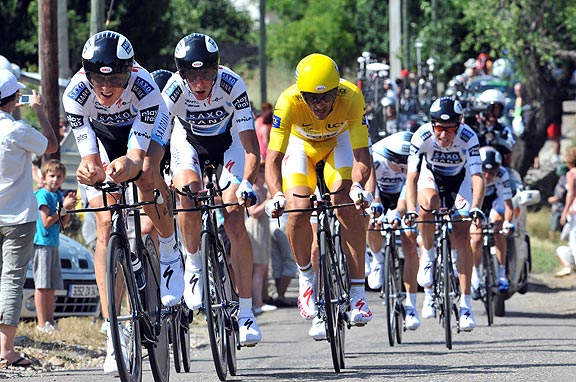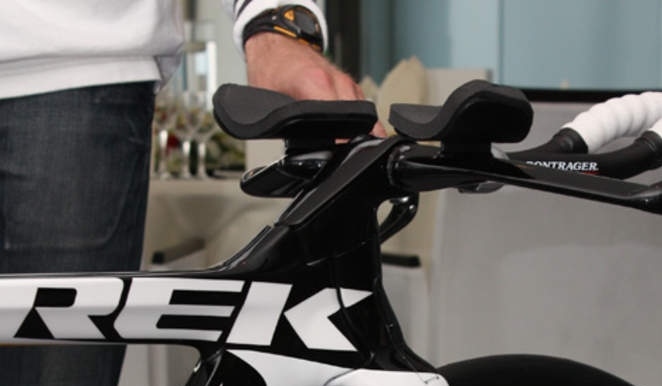Making Fast Bikes Even Faster: Cleaning Up the Front End
As I mentioned in my prior post about the TT technology on Parade during stage I of the Tour de France, the newest TT frames are moving towards a new type of front end design. Besides the protruding Cowlings exhibited by the Giant and Specialized superbikes, we see a clear trend towards eliminating standard stem and spacer setups in favor of handlebars mounted level with the top tube.


In my discussions with Cervelo’s Phil White in Kona last year he remarked that using any spacers at all beneath your stem added a significant amount of drag to the front end of your frame. Accordingly they were recommending that all their pros size their frames so to use as few spacers as possible. As we know a round cross-section is one of the worst profiles for aerodynamic drag, creating more than 10 times the drag of an equivalent sized airfoil. So for example, 3cm of spacers under your stem could create the same amount of drag as 100 cm of 1cm wide airfoil spacers due to drag coeficient and frontal area differences. A couple of years ago the MIT cycling team studied this effect in the wind tunnel and determined that using a Bento box behind the stem and spacers greatly reduced the drag by effectively turning the round cross section into an elongated, more aero shape. One of the team members, Mark Cote, now at Specialized, even designed a top tube mounted water bottle which supposedly tested very well in the wind tunnel but never made it to market. Based on the front end treatments we are seeing in the Tour de France this year this drag effect is real and significant.
The problem of course is that if the base bars are in line with the top tube you have zero adjustability in bar height once the frame size (stack) is set. Add to this the fact that at least some of these frames are only manufactured in one size (Specilaized Shiv for example). The solution to this problem seems to be to replace the stack adjustment formerly achievable by using stem spacers and different stems with the ability to raise the Aero bars above the base bar. This way you avoid the un- aerodynamic round steerer being exposed to the wind and instead replace it with much lower drag thin airfoil shaped risers.


During the team time trial we could clearly see the wide range of Aero bar riser height employed by different members of a particular team. The question here is whether we will see this trend make it to the mass market. Certainly one drawback is the fact that base bars must remain level with the top tube and hence can end up well below the Aero bars, resulting in a fairly uncomfortable base position for some riders. This is no big deal if the bike is used solely for short time trials. But for any race that requires a fair bit of climbing or for a bike that is ridden daily for training and where the rider is not spending nearly 100% of the time on the Aero bars, this could be an impractical set up. One solution might be to actually angle the base bars upward.


The new Trek speed project bike is an exception here. It appears to use a more conventional stem setup that is smoothly fared into the top tube. However the base bars are positioned above the top tube so it requires a downward transition from the bars to the top tube. You can somewhat mimic this on a conventional bike by using a Fuel Belt aero fuel box that I had a hand in designing a couple years ago and that we’ve been using since.


July 11, 2009 @ 12:43 pm
Great post, Todd! As usual!
What do you think about the Aero Bottle commonly used by long distance triathletes? Is the use of such bottle good or bad aerodynamically speaking?
Go Thor Hushovd!!
July 11, 2009 @ 8:56 pm
Thanks Jørgen- Which bottle – the aerobar bottle or aero-shaped bottle like the Bontrager or Arundel? The aerobar mounted bottle can actually improve aerodynamics of some setups, and doesn’t hurt others very much from what I understand (the straw is the worst part). When you consider the ease of drinking and refilling, it is probably always faster overall. The aero-shaped bottles probably also improve aerodynamics of most any frame. We know that the P4 took this to an extreme and it improved the drag vs the P3. Chris Lieto uses two Bontragers specially mounted so they almost fill his frame. I know he’s been in the tunnel. Considering those bottles can be a pain to use, they must improve aero. I suspect he doesn’t even fill the frame bottles. We also saw that Cervelo Test Team replaced the P4- bottles with an Arundel-like bottle.